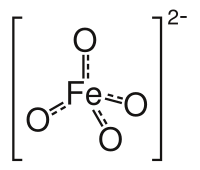
Photo from wikipedia
Abstract In this study, the microstructure of sulfidated nanoscale zero-valent iron (S-nZVI), and the reaction mechanism with cadmium (Cd) were investigated. Combining with spherical aberration-corrected scanning transmission electron microscope (Cs-STEM),… Click to show full abstract
Abstract In this study, the microstructure of sulfidated nanoscale zero-valent iron (S-nZVI), and the reaction mechanism with cadmium (Cd) were investigated. Combining with spherical aberration-corrected scanning transmission electron microscope (Cs-STEM), Raman spectroscopy, X-ray photoelectron spectroscopy (XPS), X-ray diffraction (XRD), and Fourier transformed infrared (FTIR), it was found that the one-step synthesized S-nZVI with Na2S as the sulfidation reagent is irregular in shape and consisted of heterogeneous mixtures of Fe0, amorphous FeS, and Fe3O4. The dominant reaction mechanism between S-nZVI and Cd is displacement of Fe in FeS and the formation of CdS. The effects of Cd initial concentration, Mg2+, NO3−, and humic acid (HA) on the reaction kinetics were also studied. The removal capacity of Cd by S-nZVI can reach up to 495 mg/g, which is significantly higher than other S-nZVI and adsorbents. The reactions follow pseudo-second-order adsorption model, with chemisorption as the rate limiting step during the displacement reaction. Low concentration of Mg2+ (
Journal Title: Chemical Engineering Journal
Year Published: 2020
Link to full text (if available)
Share on Social Media: Sign Up to like & get
recommendations!